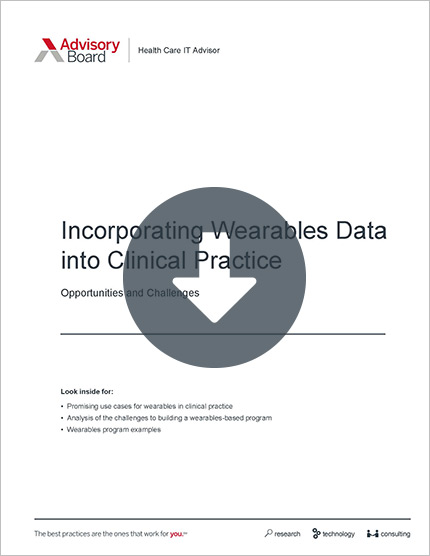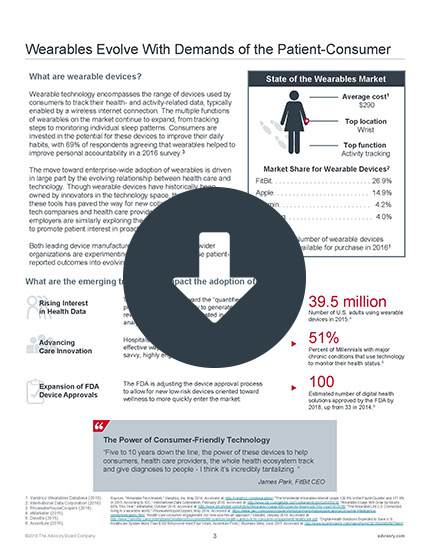Auto logout in seconds.
Continue LogoutHospitals across the country are ditching the traditional paper patient ID bracelet and introducing high-tech alternatives—including some that eliminate the wristband altogether, Lucette Lagnado reports for the Wall Street Journal.
The new hospital ID bracelet
Upgraded ID bracelets stand to benefit hospitals and patients alike, Lagnado reports.
For hospitals, a smarter bracelet can help the hospital run more efficiently. At St. Joseph Mercy Oakland Hospital in Michigan, for example, wristbands now include technology that allows clinicians to track patients throughout the hospital "from the time they arrive to the time they leave," according to Robert Jones, head of information technology for the hospital. Through the bracelets, hospital staff can tell immediately when a patient is discharged, allowing them to "get the bed cleaned and turned around" more quickly, according to Jones.
The David H. Koch Center, a New York-Presbyterian outpatient center, similarly provides patients and their caregivers with paper ID wristbands that include tracking technology. The wristbands, which can be printed at lobby kiosks, also allow patients and family members to get through security checkpoints, according to Daniel Barchi, the hospital's CIO.
Such high-tech wristbands can help with patient recovery, too. Wake Forest Baptist Health in North Carolina uses high-tech bracelets to track how much exercise cancer patients get after surgery. "We measure the times they move from the room to the hall, and we can identify how many times a day they do that and how long they are out of the room," according to Betsy Kraft, clinical project manager for the wristbands.
Getting rid of the bracelet altogether
But even with the high-tech upgrades, hospital bracelets aren't without issues. Critics say bracelets can collect germs and be difficult to read, leading to errors.
On top of that, patients don't exactly like wearing them. Laurie Constantino, who spent time in the hospital after complications from brain cancer surgery, said, "The wristband always makes you feel that you are sick, that you are a patient."
Plus, the bracelets can be annoying, especially for pediatric patients. Paul Allen, a pediatrician at Children's Mercy Hospital in Kansas City, Missouri, said, "Kids, especially the younger ones, hate it."
To address their concerns, some clinicians are hoping to eliminate the bracelets entirely.
One is Laurie Constantino's husband, Peter Costantino, chair of head and neck surgery at Lenox Hill Hospital. Costantino developed an adhesive strip called "the Shield" that serves the same purpose as a hospital bracelet but can be placed anywhere on a patient's body.
Constantino said he was inspired to create the Shield after his wife's experiences as a patient. The strip, which is usually attached to a patient's foot or arm, is wider than traditional hospital bracelets, which makes it easier to read and reduces the risk of mistakes.
Northwell Health is currently testing the Shield on 50 neurosurgery patients. One of the patients, Matthew Mindell, said the Shield "makes much more sense" than the traditional hospital bracelet, which he said was "annoying, I wanted to pull it off."
Meanwhile, with children's aversion to the bracelets in mind, Allen, of Children's Mercy, wants to retire traditional bracelets. To take their place, Allen and two other developers created the BodyGuard ID: a temporary cosmetic ink that prints patient information directly on the skin.
Unlike traditional bracelets, the ink "is not irritating, and the kids can't pull it off," Allen said. Blue Cross and Blue Shield of Kansas City last year awarded Allen's team a $15,000 innovation prize for the project, which Allen is hoping to put toward a patent for widespread use (Lagnado, Wall Street Journal, 2/20).
Your telehealth cheat sheet on wearables
Wearable technology encompasses the range of devices used by consumers to track their health- and activity-related data. As the multiple functions of wearables on the market continue to expand, consumers are becoming more invested in the potential for these devices to improve their daily habits. Wearable technology can help to facilitate patient activation and improve clinical outcomes.
The cheat sheet details how rising interest in health data, advancing care innovation, and expansion of FDA device approvals has impacted the adoption of wearables.
Don't miss out on the latest Advisory Board insights
Create your free account to access 1 resource, including the latest research and webinars.
Want access without creating an account?
You have 1 free members-only resource remaining this month.
1 free members-only resources remaining
1 free members-only resources remaining
You've reached your limit of free insights
Become a member to access all of Advisory Board's resources, events, and experts
Never miss out on the latest innovative health care content tailored to you.
Benefits include:
You've reached your limit of free insights
Become a member to access all of Advisory Board's resources, events, and experts
Never miss out on the latest innovative health care content tailored to you.
Benefits include:
This content is available through your Curated Research partnership with Advisory Board. Click on ‘view this resource’ to read the full piece
Email ask@advisory.com to learn more
Click on ‘Become a Member’ to learn about the benefits of a Full-Access partnership with Advisory Board
Never miss out on the latest innovative health care content tailored to you.
Benefits Include:
This is for members only. Learn more.
Click on ‘Become a Member’ to learn about the benefits of a Full-Access partnership with Advisory Board
Never miss out on the latest innovative health care content tailored to you.



